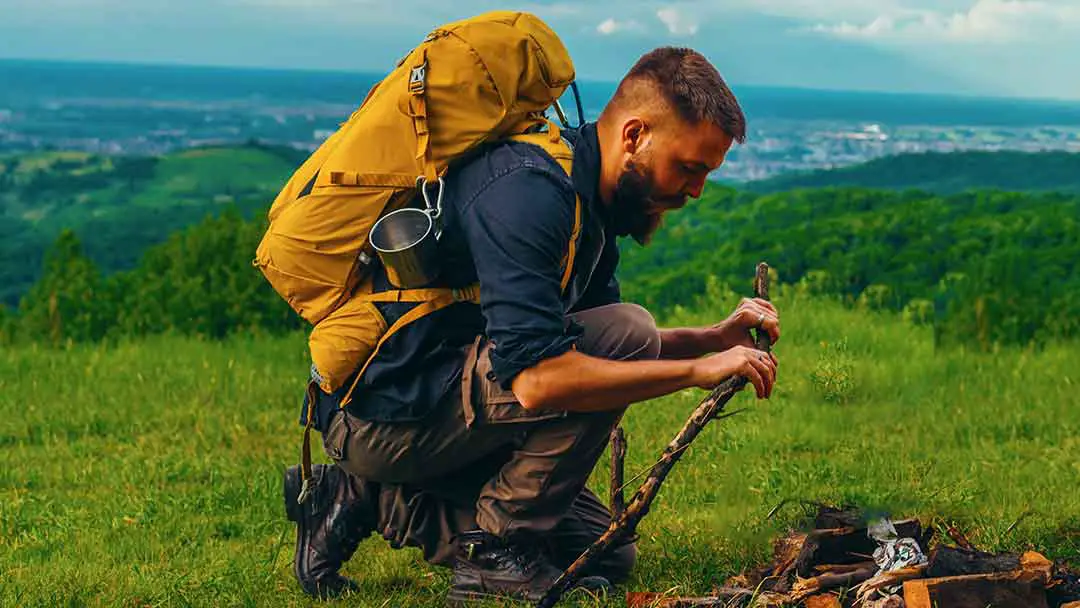Is Fastpacking Safe? 10 Things to Consider

As an Amazon Associate we earn from qualifying purchases made on our website. If you make a purchase through links from this website, we may get a small share of the sale from Amazon and other similar affiliate programs. You can read our complete legal information for more details. By using this site, you agree the information contained here is for informational purposes only. For specific medical questions, consult your doctor. NO information on this site should be used to diagnose, treat, prevent or cure any disease or condition.
Fastpacking combines hiking, running, camping, and spending time out in the wilderness. However, there are certain precautions one should take to keep this activity safe.
In this article, I will address some of the more common safety concerns that most of the fastpacking community abides by. Hopefully, these help you get home in one piece!
The essentials you need to return home from an adventure
In the past, have you ever felt pressed for time but craved a huge adventure? Let me explain what fastpacking is all about.
Not every day do you get to mix backpacking with trail running in a new and exciting way. It enables us to cover more ground in a shorter period, allowing us to see more and feel more accomplished.
Fastpacking is all about keeping things as simple as possible. This type of travel may appeal to ultralight explorers who don’t want to pack too much but still want to see the world.
Yet, fastpacking is not a one-size-fits-all endeavor. With a hefty pack, traveling long distances becomes more challenging. This means you should pack only the necessities that will allow you to complete your trip while keeping you secure and comfortable.
Otherwise, there isn’t anything to be said. Nothing less than this will do. Everything about this is essential and uncomplicated.
10 things to keep you safe when fastpacking
It’s not necessary to cut corners on essentials to keep your backpack as light as possible.
As already said, a primary concern should be protection and safety. While planning your excursion, you’ll need the Ten Essentials checklist to help you deal with crises or emergencies.
1. Navigation (Map & Compass)
I have a Garmin watch where I have the downloaded route to follow; I also have this route on my phone. These are the primary ways in which I navigate on a fastpacking adventure.
However, you should carry a paper map and compass and know how to navigate using them. If your gadgets fail you, you need to know a more basic form of navigation to get you home safely.
2. Sun Protection
Protecting yourself from the sun is vital. You want to avoid getting burnt at all costs; it is painful but can also lead to blistering, dehydration, and infections.
You also need to ensure you do not get sunstroke and related issues like diarrhea and dehydration.
These are killers in wild and remote places, so you need to avoid them. If you are fastpacking in a scorching area, consider fastpacking at night and sleeping during the hottest parts of the day.
3. Insulation
One of the keys to survival and emergency preparedness is keeping warm in the great outdoors, especially at night.
You need to have a sleeping system of a sleeping mat, sleeping bag, and shelter that is sufficient to keep you warm and happy at whatever the coldest temperatures are likely to be on the trip.
You also need the proper clothing to keep you at a comfortable temperature during the day when you are on the move.
4. Illumination (Headlamp or Running Light)
Even if the days are long and you intend to be asleep before it gets dark, you should always have a head torch.
This could be for clicking off extra miles in the dark or to find a spot to go for a pee in the middle of the night.
A torch is a vital way to help you stay safe at night. You also would be wise to take spare or extra batteries to ensure they do not fail you.
5. First-Aid Kit
This is a must-have item; you need a first-aid kit to help you if things go wrong. It should include simple things like plasters, bandages, painkillers, and blister treatment.
However, it also needs to be tailored to your needs for the specific trip and environment you are fastpacking in.
It is easy to convince yourself not to take a first-aid kit because you could take it 99 times and not need it, but it should be with you for that one time you need it.

6. Fire Starting
Whether you need fire as a planned way to keep warm and to cook food, or if suddenly the weather is a lot colder than expected, you should have a way of starting a fire in the wild.
This could be an absolute lifesaver, as it could also be used as a beacon to attract attention if you are injured and need help.
- Bushcraft Survival Ferro Rod Fire Starter Kit (Higher Quality)
- FOSTAR Drilled Ferro Rod Fire Starter (Cheaper)
Outside of emergencies, you should check fire regulations on your trail before starting one.
7. Knife or Multi-Tool & Repair Kit
A good bushcraft knife or multi-tool is definitely worth the weight. Also, repair kits as essential for a good night’s sleep if your inflatable sleeping mat or shelter fails you.
Of course, there is no point taking them if you don’t know how to use them, so make sure you are familiar with them before you head out on your fastpacking adventure.
8. Extra Food
You will be moving relatively long distances over many days, possibly, so you will need more food than you would eat on an average day.
Most likely, you will carry a lot of the food with you, but also research where there are restaurants, cafes, and shops along your route. This will allow you to consume extra calories or replace spoiled or damaged food.
To see what I pack, check out my food packing list and suggestions here.
9. Extra Water
There is only so much water you can sensibly carry; therefore, you will need to resupply at some point.
So make sure you know how to do this, which will be different depending on where you are staying.
For example, you may need to take a water filter & water purification tablets, or you will need to know where there may be taps, trail angels, or places you can buy water.
I like to use Find a Spring and check to see if there are any natural springs along the route. You should always use caution and filter your water if the spring is suspect. You don’t want a giardia infection, that sucks and I can tell you from experience.
10. Emergency Shelter
In addition to your bivvy or tent, you should have an emergency shelter with you, for example, an emergency blanket or bag. These could be the difference between surviving a night or an unexpected weather front.

One Last Thing: Conditioning
I’ve met plenty of newer fast packers out on the trail that were not in the best of condition from a physical standpoint, and they had to give up. Usually, they plan a trip that is too long, or they start too fast and don’t know how to pace themselves.
Also, some people compete with others on the trail, but deep down, Fastpacking isn’t a sport. You’re only competing with yourself.
If you’re starting out, I highly suggest you keep your trips shorter and gradually build up to longer and more difficult excursions. It’s not worth overextending yourself due to a strong EGO.
The good news is that I have shared my personal training routine in this article, which will hopefully give you a good idea of what it takes to get into fastpacking shape. One other article that will better prepare you is “The Ultimate Fastpacking Kit List.” That list is next level!
Conclusion
Fastpacking is a fun hobby, but bad things can happen in any area of life. So, be sensible and ensure you cover the knowns and can adapt to the unknowns.
If you’re somewhat newer to fastpacking, I suggest reading The Fastpacking Ultimate Guide. This is where I outline the important aspects of fastpacking. Either way, I hope to see you out on the trail!



